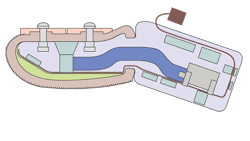A new tactile sensor from SynTouch performs three notable functions. First, the impedance is measured by using a flexible bladder against an array of sensing electrodes in a rigid core. This is to obtain a deformity measurement, much like the human finger uses ductile skin and flesh against a rigid bone. This is where the fingernail is needed—it causes budges in the skin that allow shear forces to be detected.
Second, micro-vibrations are registered by a pressure sensor mounted on the inside of the sensor’s core, enabling the measurement of surface roughness and texture. This is where the fingerprints add a lot of value, as they interact with textures.
Third, in the sensor’s thermistor, the electrical resistance is dependent on temperature. The sensor (like a human finger) generates heat, and the thermistor allows their sensor to detect how it’s exchanged when it touches something.
By placing all electronics inside a rigid core and covering them with a compliant replaceable bladder, this sensor is able to function more robustly while providing sensitive human-like measurements. Electronics such as this could someday be a normal sight on robotic hands, offering a real human touch that allows a robot to identify material and grip it appropriately.
This file type includes high resolution graphics and schematics when applicable.
About the Author
Jeff Kerns
Technology Editor
Sign up for our eNewsletters
Get the latest news and updates



